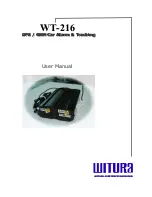
5
Overview
Overview
The Humminbird Sensor Accessory Kit includes the following items depending on the Sensor model you purchased:
GPS Reciever
(AS GR16, AS GR50, AS GRP)
Sensor with internal GPS Receiver.
Cable length is 20 ft (6m).
Hardware kit for stem or deck mounting
Installation Guide
GPS Receiver/Heading Sensor
(AS GPS HS)
Sensor with internal GPS Receiver and Compass.
Cable length is 20 ft (6m).
Hardware kit for stem or deck mounting
Installation Guide
NOTE:
The stem mount is not included. To purchase extension cables and other accessories, see our Web site at
humminbird.com
or call
Humminbird Technical Support at
1-800-633-1468
.
The following functionality will be supported by your trackplotter when it is connected to the Sensor:
Δ
View current position
Δ
View current track (breadcrumb trail)
Δ
View precision speed and heading from your GPS receiver
Δ
Save tracks and waypoints
Δ
Travel a route and navigate from one waypoint to the next
Δ
View the heading from the Heading Sensor (AS GPS HS only)
NOTE:
For details about the installation of your GPS Reciever or Heading Sensor, refer to the installation guide included with your accessory.
Operations manuals and installation guides can be downloaded from our Web site at
humminbird.com
.
NOTE:
If your control head is a chartplotter, there will be additional functionality when the Sensor is connected to the control head. See your
control head operations manual and the Humminbird Waypoint Management Guide for more information. The manuals are included on the
CD that was included with your control head, or you can download these manuals from our Web site at
humminbird.com
.
How GPS and Trackplotting Work
Your Humminbird uses GPS to determine your position and display it on a grid.
GPS uses a constellation of satellites that continually send radio signals to the earth. The GPS receiver on your boat receives
signals from satellites that are visible to it. Based on time differences between each received signal, the GPS receiver determines
its distance to each satellite. With distances known, the GPS receiver mathematically triangulates its own position. With 5 updates
per second, the GPS receiver then calculates its velocity and bearing.
GPS was originally intended for military use; however, civilians may also take advantage of its highly accurate position capabilities,
typically /– 2.5 to 10 meters, depending on your conditions and your Humminbird model. This means that 95% of the time,
the GPS receiver will read a location /– 2.5 to 10 meters of your actual position.
Your GPS receiver also uses information from WAAS (the Wide Area Augmentation System), EGNOS (the European Geostationary
Navigation Overlay Service), and MSAS (the MTSAT Satellite Augmentation System) satellites if they are available in your area.
How the Heading Sensor Works
The magnetic compass is one of the first known instruments for navigation. It relies on the earth’s magnetic field to align a
magnetic pointer towards North, also known as Magnetic North.
If your accessory includes a Heading Sensor, the control head will display the heading from the internal compass in digital format.
The Heading is the direction the boat is pointing, where 000° is North, 090° is East, 180° is South, and 270° is West.





































